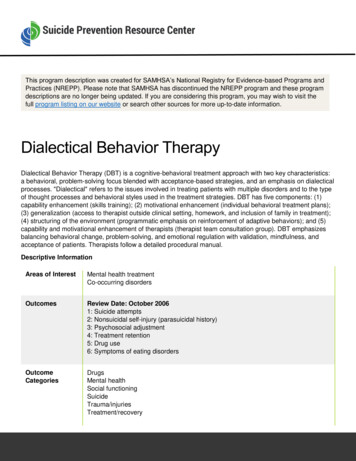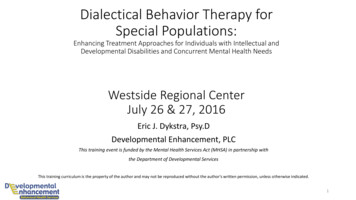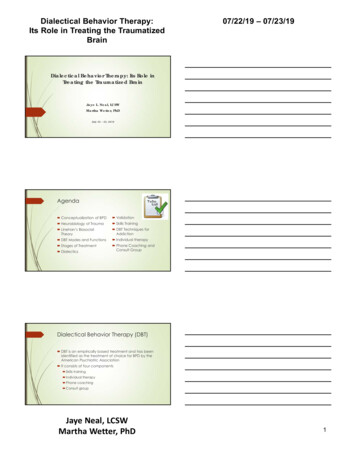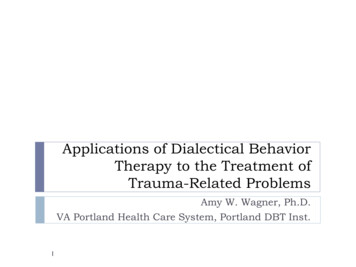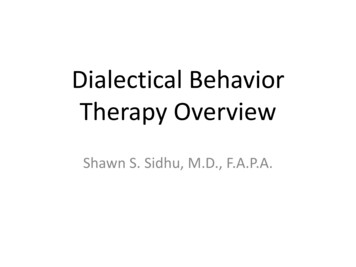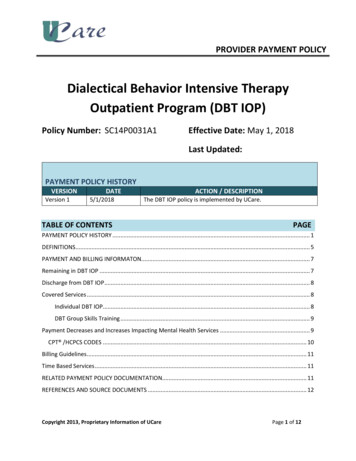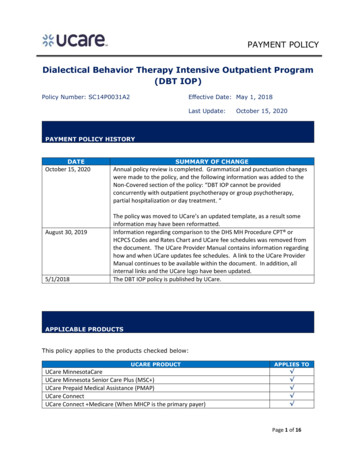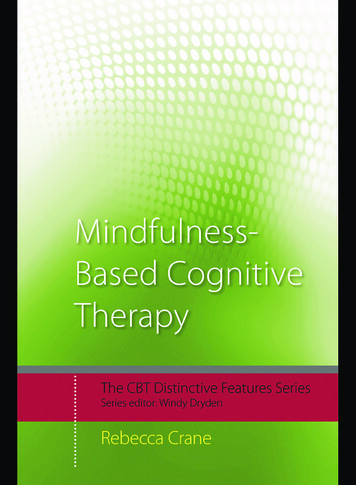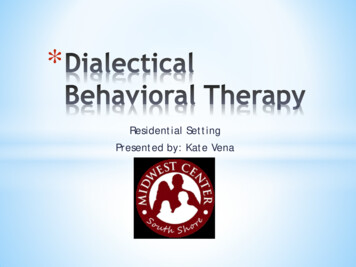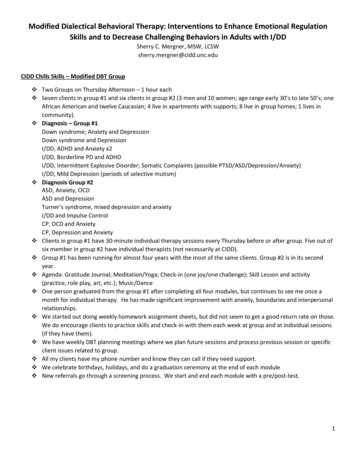
Transcription
Modified Dialectical Behavioral Therapy: Interventions to Enhance Emotional RegulationSkills and to Decrease Challenging Behaviors in Adults with I/DDSherry C. Mergner, MSW, LCSWsherry.mergner@cidd.unc.eduCIDD Chills Skills – Modified DBT Group Two Groups on Thursday Afternoon – 1 hour each Seven clients in group #1 and six clients in group #2 (3 men and 10 women; age range early 30’s to late 50’s; oneAfrican American and twelve Caucasian; 4 live in apartments with supports; 8 live in group homes; 1 lives incommunity). Diagnosis – Group #1Down syndrome; Anxiety and DepressionDown syndrome and DepressionI/DD, ADHD and Anxiety x2I/DD, Borderline PD and ADHDI/DD, Intermittent Explosive Disorder; Somatic Complaints (possible PTSD/ASD/Depression/Anxiety)I/DD, Mild Depression (periods of selective mutism) Diagnosis Group #2ASD, Anxiety, OCDASD and DepressionTurner’s syndrome, mixed depression and anxietyI/DD and Impulse ControlCP, OCD and AnxietyCP, Depression and Anxiety Clients in group #1 have 30-minute individual therapy sessions every Thursday before or after group. Five out ofsix member in group #2 have individual therapists (not necessarily at CIDD). Group #1 has been running for almost four years with the most of the same clients. Group #2 is in its secondyear. Agenda: Gratitude Journal; Meditation/Yoga; Check-in (one joy/one challenge); Skill Lesson and activity(practice, role play, art, etc.); Music/Dance One person graduated from the group #1 after completing all four modules, but continues to see me once amonth for individual therapy. He has made significant improvement with anxiety, boundaries and interpersonalrelationships. We started out doing weekly homework assignment sheets, but did not seem to get a good return rate on those.We do encourage clients to practice skills and check-in with them each week at group and at individual sessions(if they have them). We have weekly DBT planning meetings where we plan future sessions and process previous session or specificclient issues related to group. All my clients have my phone number and know they can call if they need support. We celebrate birthdays, holidays, and do a graduation ceremony at the end of each module New referrals go through a screening process. We start and end each module with a pre/post-test.1
What is DBT? DBT stands for Dialectical Behavior Therapy DBT is a specific type of cognitive-behavioral psychotherapy (CBT) created in the 1980’s by Marsha Linehan,Ph.D., an American Psychologist An evidence based model of therapy that uses skills training and the therapeutic relationship to manage strongemotions, distorted thinking and behavioral dyscontrol. A bio-psycho-social approach to psychotherapy that modifies traditional behavioral approaches and combinesthem with Buddhist concepts like acceptance and mindfulness. Uses group work (skills training), individual therapy and self-monitoring to change target behaviors. Originally created for the treatment of Borderline Personality Disorder, it is now used in a variety of treatmentsettings with a range of individuals, conditions or mental health disorders (i.e., dual diagnosis, substance use,eating disorders, complex trauma, suicidal adolescents; ASD, and IDD). DBT has been described as being designed for the severe and chronic, multi-diagnostic, difficult to treat clientswith both Axis I and Axis II disorders.Cognitive Behavior Therapy (CBT) CBT teaches individuals how their thoughts, feelings, and behaviors influence each other. CBT teaches individuals to use this relationship between thoughts, feelings, and behavior to their advantage. This approach believes that positive change in one factor (changing a thought or behavior) can lead to positivechanges in all factors. Evidence-based approach that has been proven to help individuals with various mental health issues such asdepression, anxiety disorders or substance use problems. Also used with individuals with high functioning ASD(Michelle Garcia Winner’s Social Thinking methodology). CBT is structured, goals-oriented and focused on the present. CBT teaches skills and strategies like problem-solving or realistic thinking to help individuals make changes totheir thoughts, feelings, and behaviors.Dialectical Behavior Therapy (DBT) DBT is based on CBT, with greater focus on emotional and social aspects. DBT was developed to help people cope with extreme or unstable emotions and harmful behavior. DBT is an evidence-based approach which helps individuals regulate emotions, cope with stress and improveinterpersonal relationships. It started as a treatment for borderline personality disorder, and current research shows it may help with manydifferent mental health issues or concerns, particularly with self-harm. The key differences between CBT and DBT are validation, acceptance and relationships. DBT teaches individuals that their experiences are real, and it teaches them how to accept who they are,regardless of challenges or difficult experiences. Relationships are important in DBT – including the relationship between the client and the DBT practitioner Validation and acceptance is critical in the therapeutic relationship as well as in peer to peer relationships ingroup.What is Dialectics? The idea that two opposite or contradictory ideas can exist at the same time. Simply said: It means two opposingthings being true at once.2
Thinking dialectically means we maintain openness to contradictory and/or polarized thoughts and points ofview. We work to blend these thoughts into a “truth” which best explains the reality at the moment.Examples: You love your family member, but you are angry because they are always late. As a parent you are often doing the best you can AND you are still wanting to do better. Teenagers want to do things on their own AND they still rely on their parents. We accept the client where they are AND we still push them to change. DBT therapists understand and validate, what clients are doing based on who they are, what they have beentaught or what is in their history AND we believe that they can also become more skillful to have a better life.Five Main Tasks of the DBT Therapist Work to expand client capabilities. Motivate the client to engage in new behaviors. Generalize the use of the new behaviors. Establish a treatment environment that reinforces progress. Maintain capable and motivated therapists.Three Components Needed to Accomplish These Tasks Individual psychotherapy Skills training group Phone coaching Supervision/case consultation groupsDBT is a Strengths-Based Approach to Working with Clients People are active participants in the helping process (empowerment). All people have inherent strengths, often untapped or unrecognized. Strengths foster motivation for growth. Strengths are internal and environmental (supports/resources).DBT’s Bio-Social TheoryBiological dysfunction in emotion regulation system Invalidating environment Pervasive Emotional DysregulationWhat is the impact on individuals with I/DD? Social Risk Factors Closest relationships can often be paid staff friendships may be few and/or unsatisfying Lack of familyinvolvement Challenges with social interaction, especially nuanced skills like small talk and flirting History of loss, including staff Experience of marginalization, prejudice, and stigma Experience of being taken advantage of Discouraged from having romantic relationships Lack of sexual contact and/or knowledge Stressful social interactions associated with increased psychological distress Environmental Risk Factors History of multiple placements Institutionalization Unfulfilling job placements or day programs Limited access to enrichment activities Lack of financial independence Lack of privacy3
Strict routines and lack of choice Service providers from different disciplines and agencies Cognitive Risk Factors Challenges with abstract thinking Difficulty with perspective-taking Reduced memory for learned coping skills Impaired reasoning and problem-solving Limited executive functioning (multi-tasking, planning, organizing) Receptive language deficitDifficulty identifying “why” they are experiencing an emotion Psychological Risk Factors Taught to be “compliant” and discouraged from doing tasks independently, leading to experience ofhelplessness Experience of shame around having a disability Fear of new experiences due to feeling incapable Not having a “voice,” even if verbal, due to others not consulting them in decisions that impact them Being “bailed out” of challenging situations and not being given the opportunity to learn from mistakes Historyof abuse, bullying, and/or rejection Defense mechanisms may be primitive (fight or flight) Impaired capacity for insight, resulting in an external focus for the cause of emotional distress Stress Risk Factors Stress – mental or emotional tension due to any event perceived by the individual to be demanding, straining, orchallenging Chronic stress can impact physical and mental health Levels of stress may be higher Fewer resources or coping skills to deal with stressWhat Do We Know About the Treatment of Individuals with I/DD?Graphic - https://janinafisher.com/flip-chart.html High rates of abuse and neglectincluding physical, sexual andemotional High rates of bullying Victims of violent crimes Family stress can turn into familyviolence Co-occurring mental healthchallenges Institutionalization Restraint and seclusion Abandonment and isolation Excluded from society – one of themost marginalized populations Discrimination, prejudice, andmicroaggressions Person not seen for who they are– see disability first No advocates – don’t learn how toself-advocate Invalidated4
Trauma Leads To: Emotional Dysregulation Intolerance to Stress High Anxiety Distorted Thoughts Easily Triggered – Reactive – Unprocessed Memories Poor Interpersonal Relationships Agitation – Aggression – Verbal/Physical Violence - Suicide/Homicide Withdrawal/Isolation Low self-esteem/confidence Helplessness/Hopelessness Poor Sleep – Nightmares Somatic Complaints/Illness Addictions Co-occurring Mental Health IssuesWhat is Invalidation? The negation that a person or their feelings or opinions are invalid and wrong. Invalidation includes: Blaming Judging Denying Criticizing Minimizing feelings or experiences Implies the person is wrong, overreacting, or lying. Invalidation Emotional Abuse Invalidation TraumaWhy use DBT with Individuals with I/DD? DBT teaches modulation of extreme emotions thus reducing negative behaviors that can result from theseemotions. DBT teaches the individual to trust their own emotions, thoughts and behaviors. DBT is a skills-based model that is consistent with psychoeducational and habilitative practice DBT is fundamentally non-pejorative (non-belittling or negative) in its language and positive in its aspirationswithout blaming the victim. DBT has a strong focus on teaching individuals to advocate for themselves – developing problem-solving,communication, assertiveness and self-advocacy skills, a sense of independence and a feeling of empowerment. Skills can be reinforced and used by family members and group home/support staff.The Core of DBTValidation and Problem-Solving form the core of DBT. All other strategies are built around them.Validation strategies are acceptance-basedEngaging the client in understanding actions, emotions and thoughts.Problem-solving strategies are change-based5
Looking at behavior, committing to change and taking the steps to change. Validation is not necessarily agreeing.Validation does not mean you like it.Only validate the valid!Validate: Emotions – feelings, wanting, suffering, difficulties Thoughts – beliefs, opinions Actions Abilities – StrengthsProblems Solving:Chain Analysis - Examines events and situational factors leading up and following a problematic response.What is Validation? The recognition or affirmation that a person or their feelings or opinions are valid or worthwhile.Graphic from: The Child, Adolescent and Family Recovery Center Presentation (2014) – Walking the Middle Path & Biosocial Theory e-path---the-child--adolescent-and-family6
Adapting Psychotherapy/Group Therapy for People with Intellectual and Developmental DisabilitiesMyth: Psychotherapy is not effective for people with I/DDTruth: If adapted/modified psychotherapy can be effective for people with I/DD! Provide information in a variety of different modes Both auditory and visual Uses all senses (unless sensory issues) Videos/Drawings/Visuals Simplify language Directive and active approaches Change complicated terms – teach to your audience Ask if a word or concept is understood – give examples Concrete activities Modeling, role-plays, art, clay, mirrors, games Break things into smaller parts Give real life examples Maintain structure Group guidelines – expected vs. unexpected behaviors Consistent agenda format Allow time for sharing Deal with conflicts in “real time” End on positive note – music/dance Strength-based instruction Concrete skills building Built-in-repetition of key information Share with family, group home and/or support staff – helps to generalize learning and practice of the skills.(Also, can be helpful to family or support staff). Ask for feedback from clients Incorporate their interests Be Creative/Have Fun!VALIDATE!!Graphic from: Clarify Counseling DBT – DBT Therapy Components (2015). o-Social-Spiritual Model of Change/HealingSelf-CarePHYSICALHot bath or showerDeep breathingWalk in natureMeditation/YogaListen to body ExerciseTake a napScream into a pillowPhysical/sexual healthEat healthy foodEMOTIONALListen to musicCryTalk to therapist/friendCookGet a manicure/pedicureSing/DanceListen to a meditationAffirmationsWrite in journalMENTALReach out for supportAffirmationsVisualize a stop signRead a book/journalTalk to a friendWatch a movieDo a puzzle or craftDo a thought recordSPIRITUALMeditationJournalPrayBe in natureVolunteerListen to musicPractice mindfulnessAttend a faith-basedCommunityYoga7
Four Main DBT SkillsHow we use theseskills AwarenessAcceptanceAction Change!Core Mindfulness Skills Mindfulness is a core DBT Skill and is woven into all of our group sessions. Studies have shown that mindfulness skills are effective at reducing depression, anxiety, chronic pain and addictivebehaviors Practicing mindfulness regularly can increase tolerance to distressful situations, increase relaxation and can improveone’s ability to cope with difficult situations.Three States of MindAbove graphic from: Therapeutic Oasis of the Palm Beaches (2019) - -in-wise-mind-dbt-skills-foreveryone/8
Core Mindfulness SkillsEach group starts with a mindfulness activity: Music, Guided Meditation (You Tube); Yoga; Movement What Skills – helps us know what to do Observe/pay attention to the present moment Describe – thoughts and feelings Self-Awareness Participating – being totally present when engaging in an activity Awareness How Skills – helps us to know how to do it Non-Judgmentally – be gentle with self and others empathy One-Mindfully – do one thing at a time focus and attention Effectively – focus on doing what works – choosing actions that move you to your goals – do the best youcan in the momentEmotional RegulationDefined as a complex process that involves initiating, inhibiting, or modulating one's state or behavior in a givensituation. For example: We have a subjective experience (feelings), cognitive responses (thoughts), emotion-relatedphysiological responses (example heart rate or hormonal activity), and emotion-related behavior (bodily actions orexpressions).Emotional Regulation Skills Teach how to identify, describe and understand emotions and emotional experiences. Teach how to reduce vulnerability to negative emotions. Teach how to reduce emotional suffering. Teach how to increase positive emotions.BRING IT DOWN! TURN IT AROUND!Core Emotional Regulation Skills - Skill #1Teach About Emotions – Developing awareness requires identifying and understanding emotions Goal: Develop Inner Awareness: Identify Our Emotions Understand Our Emotions Learn How Emotions Show Up in Body Learn to Regulate Own Emotions Learn The Difference Between Thoughts and Emotions Learn How Our Thoughts and Emotions Impact Our Own Behavior Goal: Develop Outer/Other Awareness: Understand Others Have Emotions Understand Others Have Thoughts Understand How Our Behavior Impacts Others Thoughts, Emotions and Behavior Teach Primary Emotions FLASH FEAR - LOVE - ANGER - SAD – HAPPY Learn Emotion Recognition Facial Expressions – Emotion Posters; Reading Faces; Mirrors Tone of Voice - Emotions Games Teach Secondary Emotions – that come out of primary emotions – Emotion Wheel9
The Zones of RegulationTHE SIZE OF MY EMOTIONSKuypers, L. (2011). Zones of Regulation, San Jose, CA: Think Social Publishing.Buron, K. D., & Curtis, M. (2003). The Incredible 5-Point Scale: Assisting students with autism spectrum disorders in understanding social interactionsand controlling their emotional responses. Shawnee Mission, KS: Autism Asperger Publishing Company.THE SIZE OF THE PROBLEM Scale 1-10 or 1-5 visual. List what type of problem is 10, 5, 110
Discuss descriptions of problems and determine where they fit on scale.Define what makes a problem big or small.What types of emotions are associated with different levels of problems?Discuss how different problem levels impact a situation over time.Discuss how to sort out and analyze that little problem.How many people does it take to solve this problem?Five Point Scales Can Be Created for Different Issues – ExamplesTEACH ABOUT HOW FEELINGS SHOW UP IN THE BODY - BODY MAPPING/DRAWINGSHow does Anger show up in the body?How does Fear show up in the body?TEACH THE DIFFERENCE BETWEEN THOUGHTS AND EMOTIONSTeach about ThoughtsTalking Bubbles Words that come out of my mouth.11
Public - other people can hear my talking bubble words. Talking bubble words can affect how other people feel.Thinking Bubbles Words that I think inside my head Private - no one can hear my thinking bubble words Thinking bubble words are secret, so they cannot hurt other people’s feelings. Having a thought vs. blurting it out Thinking and Saying Thoughts – Green Okay; Yellow Caution; Red No (Leave it in your thoughtbubble).TEACH ABOUT THE RELATIONSHIP BETWEEN THOUGHTS, FEELINGS AND BEHAVIORCore Emotional Regulation Skills – Skills #2Opposite Action This skill helps a person identify whether or not these actions make sense in the moment and what to doabout them. Doing the opposite of your impulse that’s consistent with a more positive emotion. Affirmations and Inspirations – looking at or drawing motivational statements or images. Doing something funny or cheering – funny movies, TV, books12
Core Emotional Regulation Skills – Skills #3Check the Facts This skill helps a person to identify whether they are blowing things out of proportion or placing too muchimportance on their emotions when it’s happening. This skills helps to reduce the intensity of the emotions.Ask the following questions to “check the facts”: What event triggered my emotion? What interpretations or assumptions am I making about the event? Does my emotion and its intensity match the facts of the situation? Or does it just match my assumptions of thesituation? What do I know about ?Core Emotional Regulation Skills – Skills #4ABCA – Accumulate Positive Emotions: Increase positive experiences and pleasant activities Build a “Life Worth Living” by making long term changes that make more positive events more possible Be mindful of positive experiences; Be “unmindful” of worries; o DO NOT THINK ABOUT when something will end, whether or not it is deserved orhow much will be expected now.B – Build Mastery: Do things that create a sense of accomplishment.C- Cope Ahead of Time with Emotional Situations: Figure out effective responses in advance of situations.13
Core Emotional Regulation Skills – Skills #5P.L.E.A.S.E. This skill helps a person understand the link between body and brain. This skills helps a person that they can manage their emotions if they also manage their health and body.Remember to: PL – Treat Physical Illness E – Eat Healthy A – Avoid Mood-Altering Drugs S – Sleep Well E – ExerciseFollowing these suggestions helps to keep one’s body healthy and happy, which makes it easier to keep one’s mindhappy and healthy.Core Emotional Regulation Skills – Skills #6Paying Attention to Positive Events Humans are surprisingly good at filtering out the positive and focusing on the negative. It’s natural, but it’s nothelpful! This skill helps are person pause and refocus onto the positive if they are paying too much attention to thenegative. This skills encourages practicing by doing one small, positive activity every day, focusing on the good parts of theactivity as it is being done. This skill helps ignore minor issues and notice the enjoyment, pleasure, and fun!Some small, positive activities include: Have a good unrushed meal. Watch a movie. Visit with friends or family. Visit a local attraction like a zoo or museum. Go for a walk. Put on headphones and do nothing but listen to music. Have a picnic. Give yourself a relaxing night in. Try a new hobby.Distress Tolerance Skills - (Coping with Stress) Teaches strategies that focus on how to tolerate distress, without engaging in impulsive and self-destructivebehaviors. Focuses on distraction and self-soothing techniques, and strategies to handle manage and eventually come toradically accept difficult situations or traumatic events in their lives.14
Core Distress Tolerance Skills – Skill #1Core Distress Tolerance Skills – Skill #2TIPP Skills - help make the emotions during a crisis feel more manageable.TemperatureIntense exercisePaced BreathingPaired Muscle Relaxationhttps://www.youtube.com/watch?v cIXQOb4klUw&t 5s TemperatureDuring a crisis, our body tends to feel hot. Changing your body temperature by splashing cold water on your face,standing in front of the AC, squeezing an ice cube, or eating/drinking something cold can help cool you down bothemotionally and physically. Intense ExerciseDoing an intense activity to match your feelings can help give an outlet to excess anxious energy. You don’t have to bean Olympian- you can run around the block, do jumping jacks until you are worn out, or run up and down somestairs. Increasing oxygen flow helps decrease stress levels. Paced BreathingSlow, deep breathing soothes the nervous system and increases oxygen flow. The key is to breathe out longer than youare breathing in. There are many different breathing techniques and everyone swears that theirs’ is the most effectiveone- so just pick one that works for you. Paired Muscle RelaxationWhen you tighten a muscle and then allow it to rest, it will be more relaxed than it was before you tightened it. Relaxedmuscles require less oxygen, so your heart rate and breathing will naturally slow down. Muscle relaxation also helps withbeing mindfully aware of your body- which is another big module in DBT.Core Distress Tolerance Skills – Skill #3ACCEPTSWise Mind ACCEPTS:Activities – keeping attention on other thingsContributing – taking care of others15
Comparisons – to worse situationsEmotions – opposite to what one is feelingPushing Away – decrease contact with painful cuesThoughts – thinking of other thingsSensations – intense other sensations interfere with the physiological component of current negative emotionsDISTRACTDo something elseImagine something elseSense – generate sensations to interrupt your focus on painThink about something elseRemember times when things were betterAccept that pain is part of lifeCreate meaningsTake opposite action. Do the reverse of what you feel or what you are thinkingCore Distress Tolerance Skills – Skill #4IMPROVEThe IMPROVE skill helps you tolerate distress or frustration without making it worse, and ideally, aims to make it better.It’s important to use when you can’t do anything about the crisis at hand, but might feel helpless, hurt or frustratedbecause you can’t solve the problem or change the situation. For many people, life itself feels like a constant crisis, sousing this skill to get through the feeling and gain confidence is important.ImageryMeaningPrayerRelaxationOne Thing in the MomentVacationEncouragementCore Distress Tolerance Skills – Skill #5PROS AND CON LIST Making sensible decisions can be difficult, especially when you're not in Wise Mind. Using a pros and cons list can be helpful in weighting out the consequences of your decision. It's common to have urges to engage in self-harm behavior or other self-destructive behavior while in emotionalcrisis. Make a pro and con list to decide if you should act on an urge, or tolerate an urge. It can be as simple as a few bullet points in your mind or you can dig deep and make a lengthy list on paper. Ask in this moment, which behavior is best for you? This skill can be useful in fighting impulsive urges and their negative outcomes.https://www.youtube.com/watch?v 2SI6C2ObzgcCore Distress Tolerance Skills – Skill #6SELF-SOOTHE https://www.youtube.com/watch?v 5uIANt2 A8AUse Body’s Senses Sight16
HearingTasteTouchSmellMovementUse Sensory Tools Be mindful of noise sensitivity use ear plugs, headphonesBe mindful of bright lights, flashing lights; use sunglasses, hat or visor.Be mindful of smells – aromas such as deodorant, laundry detergent, perfumes, food, etc.Be mindful of tactile sensitivities such as clothing, fabrics, creams/lotions, water, foods, etc.Have various fidgets available for the need to touch, self-soothe, and focus.Core Distress Tolerance Skills – Skill #7RADICAL ACCEPTANCE https://www.youtube.com/watch?v u 795UX9VJ8Radical - Complete and total Acceptance - Acknowledgement of what is. Accept with your mind, your heart, and yourbody. A feeling that a burden has lifted A feeling of freedom A feeling you are ready to move on Radical acceptance transforms suffering into ordinary pain.Options for painful problems: Solve the problem Change how you feel about it Accept it Stay miserableInterpersonal (Relationship) Effectiveness SkillsThe ability to interact with others.The goals of DBT’s interpersonal effectiveness skills are: Building and maintaining positive relationships.Learning how to effectively deal with conflict situations.Learning how to get along with others while also asserting your own needs and wants in the relationshipLearning to balance your own needs and the needs of others while maintaining self-respect and keeping effectiverelationships with others. Learning how to self-advocate.17
TYPES OF RELATIONSHIPSTHE HEALTHY RELATIONSHIP WHEELInitial SkillsBoundaries Establishing healthy boundaries in a relationship allows both people to feel comfortable and developpositive self-esteem. In order to establish boundaries, you need to be clear with the other person who you are, what you want,your beliefs and values, and your limits. A lot of times, we tend to focus on adjusting to others, taking time away from focusing on ourselves. Setting boundaries for yourself that reflect who you are and who you ultimately want to be will onlyenhance your relationships.HealthyFeeling responsible for your own happinessFriendships exist outside of the relationshipOpen and honest communicationRespecting differences in your partnerAsking honestly what is wantedAccepting endingsUnhealthyFeeling incomplete without your partnerRelying on your partner for happinessGame-playing or manipulationJealousyFeeling unable to express what is wantedUnable to let go18
Core Interpersonal Effectiveness Skills – Skill #1DEAR MAN https://www.youtube.com/watch?v el O72aTZzEDescribe the current situationExpress your feelings and opinions about the situationAssert yourself by asking for what you want, or saying “no” clearlyReinforce or reward the person ahead of time: explain consequencesMindfully keep your focus on your objectives: Don’t get distracted.Appear confident and effective: Let them know with your eyes/body you are paying attentionNegotiate: Be willing to give to getAdditional Skills“I” StatementsI statements tend to: Place responsibility with you, the speaker Clarify your position, feelings or opinions Build trust by giving others information about yourself Are less threateningYOU Statements tend to: Elicit a negative or defensive response Place blame or put people down Come off as being accusatory or preachyCore Interpersonal Effectiveness Skills – Skill #2Gentle: Be courteous and gentle in your approach; no attacks, threats or judging.Interested: Listen; be interested in the other person.Validate: Validate the other person’s feelings, wants, difficulties, and opinions about the situation.Easy manner: Use a little humor; smile; be calm and comfortable in the conversation.Core Interpersonal Effectiveness Skills – Skill #3FASTFair Be fair to yourself and others.Apologies Don’t look ashamed. No apologizing for being alive, or making a request. No apologies for having an opinion or for disagreeing.19
Stick to values Don’t sell out your integrity. Be clear on what you believe is the moral way to act or think.Truthful Don’t lie Don’t act helpless Don’t exaggerate No excuses Own it No blameAdditional Skills: #1 - Automatic Negative Thoughts - A negative thought that pops into your brainAdditional Skills: #2 - Non-Judgmental ThinkingJudging is often a short hand way of st
DBT is a specific type of cognitive-behavioral psychotherapy (CBT) created in the 1980's by Marsha Linehan, Ph.D., an American Psychologist An evidence based model of therapy that uses skills training and the therapeutic relationship to manage strong emotions, distorted thinking and behavioral dyscontrol.
